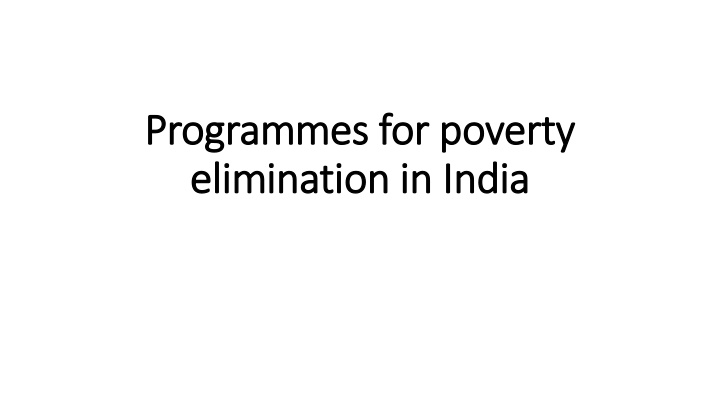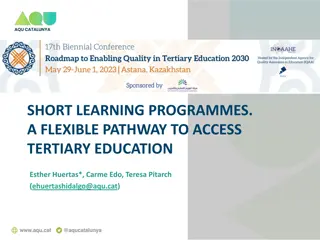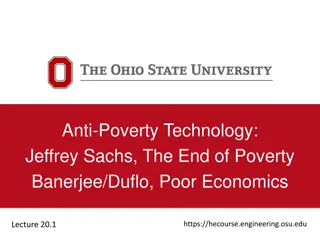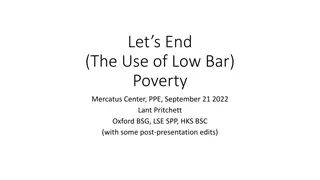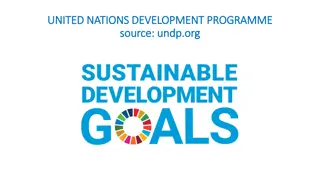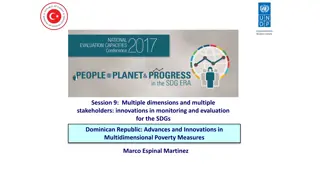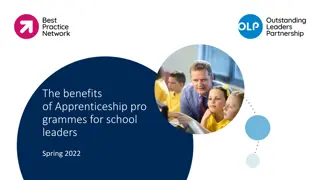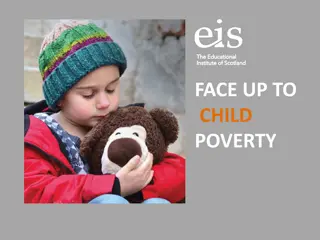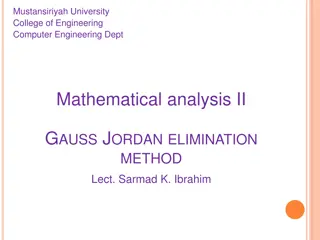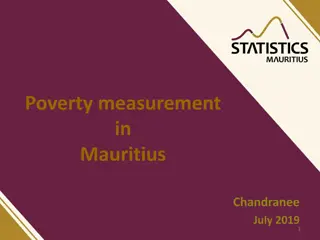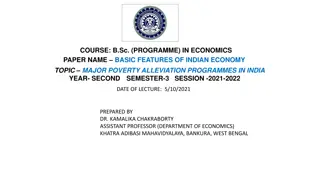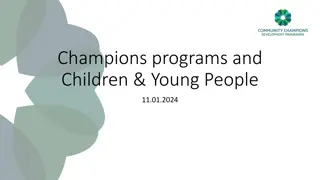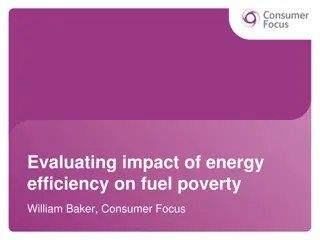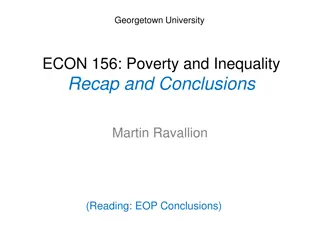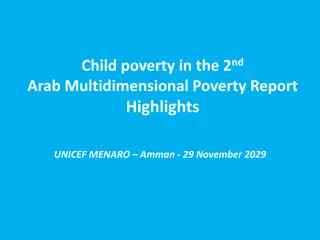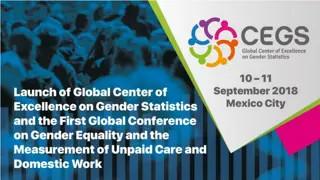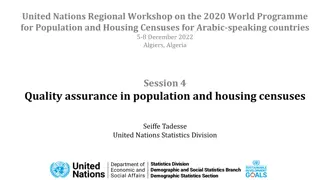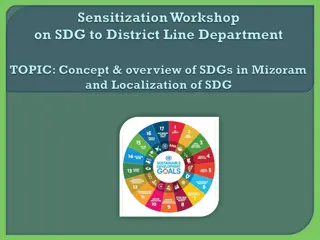Programmes for Poverty Elimination in India - Sustainable Development Goals Overview
The Sustainable Development Goals (SDGs) set by the United Nations aim to address global challenges and improve well-being. Learn about specific goals like ending poverty and hunger, ensuring good health and education, promoting gender equality, and more.
Download Presentation

Please find below an Image/Link to download the presentation.
The content on the website is provided AS IS for your information and personal use only. It may not be sold, licensed, or shared on other websites without obtaining consent from the author.If you encounter any issues during the download, it is possible that the publisher has removed the file from their server.
You are allowed to download the files provided on this website for personal or commercial use, subject to the condition that they are used lawfully. All files are the property of their respective owners.
The content on the website is provided AS IS for your information and personal use only. It may not be sold, licensed, or shared on other websites without obtaining consent from the author.
E N D
Presentation Transcript
Programmes for poverty Programmes for poverty elimination in India elimination in India
The Sustainable Development Goals (SDGs) The Sustainable Development Goals (SDGs) are a set of 17 global objectives established by the United Nations in 2015. They are part of the 2030 Agenda for Sustainable Development, which aims to address a broad range of global challenges and improve the well-being of people and the planet. Here is an overview of the 17 SDGs:
Goal-1 No Poverty: End poverty in all its forms everywhere.
Goal-2 Zero Hunger: End hunger, achieve food security and improved nutrition, and promote sustainable agriculture.
Goal-3 Good Health and Well-being: Ensure healthy lives and promote well- being for all at all ages.
Goal-4 Quality Education: Ensure inclusive and equitable quality education and promote lifelong learning opportunities for all.
Goal-5 Gender Equality: Achieve gender equality and empower all women and girls.
Goal-6 Clean Water and Sanitation: Ensure availability and sustainable management of water and sanitation for all.
Goal-7 Affordable and Clean Energy: Ensure access to affordable, reliable, sustainable, and modern energy for all.
Goal-8 Decent Work and Economic Growth: Promote sustained, inclusive, and sustainable economic growth, full and productive employment, and decent work for all.
Goal-9 Industry, Innovation, and Infrastructure: Build resilient infrastructure, promote inclusive and sustainable industrialization, and foster innovation.
Goal-10 Reduced Inequality: Reduce inequality within and among countries
Goal-11 Sustainable Cities and Communities: Make cities and human settlements inclusive, safe, resilient, and sustainable.
Goal-12 Responsible Consumption and Production: Ensure sustainable consumption and production patterns.
Goal-13 Climate Action: Take urgent action to combat climate change and its impacts.
Goal-14 Life Below Water: Conserve and sustainably use the oceans, seas, and marine resources for sustainable development.
Goal-15 Life on Land: Protect, restore, and promote sustainable use of terrestrial ecosystems, manage forests sustainably, combat desertification, halt and reverse land degradation, and halt biodiversity loss.
Goal-16 Peace, Justice, and Strong Institutions: Promote peaceful and inclusive societies for sustainable development, provide access to justice for all, and build effective, accountable, and inclusive institutions at all levels.
Goal-17 Partnerships for the Goals: Strengthen the means of implementation and revitalize the global partnership for sustainable development.
SDG Goal 1: No Poverty SDG Goal 1: No Poverty SDG Goal 1: No Poverty aims to end poverty in all its forms everywhere by 2030. This goal recognizes that poverty is a multifaceted issue that goes beyond a lack of income and resources to ensure a sustainable livelihood. It includes various forms of deprivation, such as lack of access to basic services, social discrimination, and exclusion.
Key Targets and Indicators Key Targets and Indicators 1.1 Eradicate Extreme Poverty: By 2030, eradicate extreme poverty for all people everywhere, currently measured as people living on less than $1.25 a day. 1.2 Reduce Poverty by Half: By 2030, reduce at least by half the proportion of men, women, and children of all ages living in poverty in all its dimensions according to national definitions.
Key Targets and Indicators Key Targets and Indicators 1.3 Implement Social Protection Systems: Implement nationally appropriate social protection systems and measures for all, including floors, and by 2030 achieve substantial coverage of the poor and the vulnerable. 1.4 Equal Rights to Economic Resources: By 2030, ensure that all men and women, particularly the poor and the vulnerable, have equal rights to economic resources, as well as access to basic services, ownership, and control over land and other forms of property, inheritance, natural resources, appropriate new technology, and financial services, including microfinance.
Key Targets and Indicators Key Targets and Indicators 1.5 Build Resilience: By 2030, build the resilience of the poor and those in vulnerable situations and reduce their exposure and vulnerability to climate-related extreme events and other economic, social, and environmental shocks and disasters. 1.a Mobilize Resources: Ensure significant mobilization of resources from a variety of sources, including through enhanced development cooperation, to provide adequate and predictable means for developing countries, in particular least developed countries, to implement programs and policies to end poverty in all its dimensions. 1.b Create Policy Frameworks: Create sound policy frameworks at the national, regional, and international levels, based on pro-poor and gender- sensitive development strategies, to support accelerated investment in poverty eradication actions.
Importance of Goal 1 Importance of Goal 1 Human Dignity: Ending poverty is crucial for ensuring human dignity and equality. People living in poverty often face discrimination and exclusion from society. Economic Growth: Poverty reduction is essential for economic growth and development. Reducing poverty can lead to higher productivity, economic diversification, and a more robust economy. Social Stability: Reducing poverty helps promote social stability and peace. High poverty levels are often associated with social unrest and conflict. Health and Education: Poverty reduction directly impacts health and education, leading to better outcomes in these areas and creating a more productive and educated population.
Challenges in Achieving Goal 1 Challenges in Achieving Goal 1 Economic Disparities: Persistent economic inequalities and disparities can hinder poverty reduction efforts. Global Economic Conditions: Economic downturns, trade disruptions, and financial crises can reverse progress in poverty reduction. Climate Change: Environmental degradation and climate change disproportionately affect the poor, making it harder to lift people out of poverty. Conflict and Instability: Armed conflicts and political instability can displace populations and destroy livelihoods, exacerbating poverty. Access to Resources: Limited access to financial services, education, healthcare, and other resources hampers efforts to reduce poverty.
Strategies for Achieving Goal 1 Strategies for Achieving Goal 1 Inclusive Economic Growth: Promote policies that foster inclusive economic growth and create decent jobs. Social Protection Programs: Implement comprehensive social protection systems, including pensions, unemployment benefits, and child support. Investment in Education and Health: Increase investment in education and health to enhance human capital. Empowerment of Women and Girls: Promote gender equality and empower women and girls, who are often disproportionately affected by poverty. Sustainable Development Practices: Adopt sustainable agricultural practices and resource management to ensure long-term poverty alleviation.
Achieving SDG Goal 1 requires a concerted global effort and the integration of poverty eradication measures into national and international policies. Collaboration among governments, international organizations, civil society, and the private sector is essential to address the root causes of poverty and create sustainable solutions.
Introduction: Introduction: Poverty elimination Poverty elimination requires a multifaceted approach encompassing economic, social, and political strategies. Various programs and initiatives have been implemented globally, each targeting different aspects of poverty. Here are some key programs and strategies that have been effective in poverty elimination:
1. Conditional Cash Transfer Programs (CCTs) 1. Conditional Cash Transfer Programs (CCTs) CCTs provide financial assistance to low-income families, conditional upon certain behaviors such as children attending school and receiving vaccinations. Examples include: Bolsa Fam lia (Brazil): Provides monthly stipends to low-income families, contingent on school attendance and health check-ups. Prospera (Mexico): Similar to Bolsa Fam lia, focuses on health, education, and nutrition.
2. Microfinance Initiatives 2. Microfinance Initiatives Microfinance programs provide small loans to individuals who do not have access to traditional banking services, helping them start or expand small businesses. Notable programs include: Grameen Bank (Bangladesh): Pioneered microcredit and has provided small loans to millions of people, primarily women. Kiva: An online platform that connects lenders to entrepreneurs in developing countries.
3. Universal Basic Income (UBI) 3. Universal Basic Income (UBI) UBI provides all citizens with a regular, unconditional sum of money, ensuring a basic standard of living. Pilot programs include: Finland: Conducted a UBI trial to assess its impact on employment and well-being. Kenya: Implemented a long-term UBI pilot program through the NGO GiveDirectly.
4. Social Protection Programs 4. Social Protection Programs These programs aim to provide a safety net for the poor through various means such as pensions, unemployment benefits, and food assistance. Examples include: India s National Rural Employment Guarantee Act (NREGA): Guarantees 100 days of paid work per year for rural households. Supplemental Nutrition Assistance Program (SNAP) in the USA: Provides food-purchasing assistance for low- and no-income people.
5. Educational Programs 5. Educational Programs Investing in education is crucial for breaking the cycle of poverty. Programs that focus on improving access to quality education include: Educate Girls (India): Works to improve education for girls in rural and underserved areas. Room to Read: Focuses on literacy and gender equality in education in low-income countries.
6. Health Interventions 6. Health Interventions Health programs aim to reduce poverty by addressing health-related issues that disproportionately affect the poor. Examples include: The Global Fund: Fights AIDS, tuberculosis, and malaria by providing funding to local health programs. Gavi, the Vaccine Alliance: Increases access to immunization in poor countries.
7. Agricultural Development Programs 7. Agricultural Development Programs These programs support small-scale farmers to increase productivity and income. Examples include: Alliance for a Green Revolution in Africa (AGRA): Works to improve agricultural productivity and food security in Africa. One Acre Fund: Provides financing and training to help smallholder farmers grow their way out of hunger and poverty.
8. Infrastructure Development 8. Infrastructure Development Improving infrastructure can have a significant impact on poverty reduction by enhancing access to markets, education, and healthcare. Examples include: China s Poverty Alleviation Program: Invested heavily in infrastructure, education, and healthcare to lift millions out of poverty. Millennium Challenge Corporation (MCC): Provides grants to fund country-led solutions for poverty reduction, often focusing on infrastructure.
9. Empowerment and Advocacy Programs 9. Empowerment and Advocacy Programs These programs aim to empower marginalized groups and advocate for their rights. Examples include: Self-Employed Women s Association (SEWA) in India: A trade union for poor, self-employed women workers. BRAC (Bangladesh): One of the largest NGOs, working on a wide range of programs from education to health and economic development.
10. Integrated Development Programs 10. Integrated Development Programs These comprehensive programs address multiple aspects of poverty simultaneously. Examples include: Millennium Villages Project: Aimed at demonstrating how integrated, community-led development can work. SDG Fund (Sustainable Development Goals Fund): A multi-donor and multi-agency mechanism aimed at achieving SDGs, with a focus on poverty eradication.
Conclusion Conclusion Effective poverty elimination requires coordinated efforts among governments, non-governmental organizations, international agencies, and local communities. By leveraging a combination of these programs, substantial progress can be made in reducing poverty globally.
